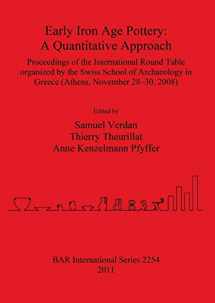
Early Iron Age Pottery: A Quantitative Approach. Proceedings of the International Round Table Organized by the Swiss School of Archaeology in Greece (Athens, November 28-30, 2008) (BAR International)
ISBN-13:
9781407308210
ISBN-10:
1407308211
Author:
S. Verdan, Thierry Theurillat, A. Kenzelmann Pfyffer
Publication date:
2011
Publisher:
British Archaeological Reports
Format:
Paperback
174 pages
Category:
European History
FREE US shipping
Book details
ISBN-13:
9781407308210
ISBN-10:
1407308211
Author:
S. Verdan, Thierry Theurillat, A. Kenzelmann Pfyffer
Publication date:
2011
Publisher:
British Archaeological Reports
Format:
Paperback
174 pages
Category:
European History
Summary
Early Iron Age Pottery: A Quantitative Approach. Proceedings of the International Round Table Organized by the Swiss School of Archaeology in Greece (Athens, November 28-30, 2008) (BAR International) (ISBN-13: 9781407308210 and ISBN-10: 1407308211), written by authors
S. Verdan, Thierry Theurillat, A. Kenzelmann Pfyffer, was published by British Archaeological Reports in 2011.
With an overall rating of 4.4 stars, it's a notable title among other
European History
books. You can easily purchase or rent Early Iron Age Pottery: A Quantitative Approach. Proceedings of the International Round Table Organized by the Swiss School of Archaeology in Greece (Athens, November 28-30, 2008) (BAR International) (Paperback) from BooksRun,
along with many other new and used
European History
books
and textbooks.
And, if you're looking to sell your copy, our current buyback offer is $0.3.
Description
Quantitative approaches in ceramology are gaining ground in excavation reports, archaeological publications and thematic studies. Hence, a wide variety of methods are being used depending on the researchers theoretical premise, the type of material which is examined, the context of discovery and the questions that are addressed. The round table that took place in Athens on November 2008 was intended to offer the participants the opportunity to present a selection of case studies on the basis of which methodological approaches were discussed. The aim was to define a set of guidelines for quantification that would prove to be of use to all researchers. Contents: 1) Introduction (Samuel Verdan); 2) Isthmia and beyond. How can quantification help the analysis of EIA sanctuary deposits? (Catherine Morgan); 3) Approaching aspects of cult practice and ethnicity in Early Iron Age Ephesos using quantitative analysis of a Protogeometric deposit from the Artemision (Michael Kerschner); 4) Development of a ceramic cultic assemblage: Analyzing pottery from Late Helladic IIIC through Late Geometric Kalapodi (Ivonne Kaiser, Laura-Concetta Rizzotto, Sara Strack); 5) Erfahrungsbericht of application of different quantitative methods at Kalapodi (Sara Strack); 6) The Early Iron Age sanctuary at Olympia: counting sherds from the Pelopion excavations (19871996) (Birgitta Eder); 7) Laire du pilier des Rhodiens à Delphes: Essai de quantification du mobilier (Jean-Marc Luce); 8) A new approach in ceramic statistical analyses: Pit 13 on Xeropolis at Lefkandi (David A. Mitchell, Irene S. Lemos); 9) Households and workshops at Early Iron Age Oropos: A quantitative approach of the fine, wheel-made pottery (Vicky Vlachou); 10) Counting sherds at Sindos: Pottery consumption and construction of identities in the Iron Age (Stefanos Gimatzidis); 11) Analyse quantitative du mobilier céramique des fouilles de Xombourgo à Ténos et le cas des supports de caisson (Jean-Sébastien Gros); 12) Defining a typology of pottery from Gortyn: The material from a pottery workshop pit, (Emanuela Santaniello); 13) Quantification of ceramics from Early Iron Age tombs (Antonis Kotsonas); 14) Quantitative analysis of the pottery from the Early Iron Age necropolis of Tsikalario on Naxos (Xenia Charalambidou); 15) Finding the Early Iron Age in field survey: Two case studies from Boeotia and Magnesia (Vladimir Stissi); 16) Pottery quantification: Some guidelines (Samuel Verdan).


We would LOVE it if you could help us and other readers by reviewing the book
Book review

Congratulations! We have received your book review.
{user}
{createdAt}
by {truncated_author}


